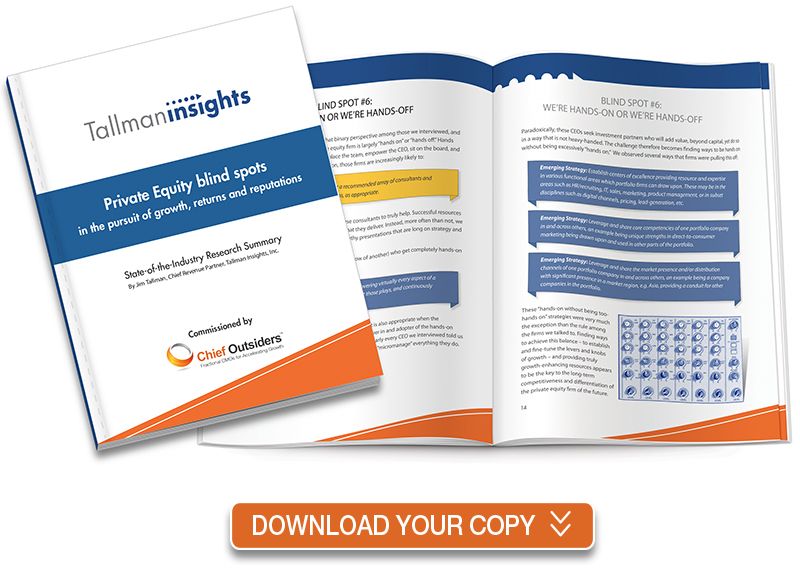
Weatherproof Growth
Every company operates within its own economic cycle, defined by internal and external pressures and trends that apply to them exclusively. Understanding where a business is in its own cycle is key for PE firms to properly value and grow the enterprise, according to Paul Sparrow of Chief Outsiders.
From the headlines, these are good times with plenty of clear weather and money-making sunshine. Marquee stats from the major stock exchanges and quarterly job reports tout an unprecedented economic expansion, despite cautionary signs like last year’s inverted yield curve. But a deeper dive into individual sectors and more specific economic metrics complicates that rosy forecast.
Investing in a Trend
Most PE firms recognize this, and take the time to understand how larger forces influence the fortunes of a given enterprise. However, that can be a tricky formula of multiple inputs, which can leave key economic indicators out of the mix, such as the relative health of a Company’s customers and suppliers. And with that clearer, more comprehensive picture, GPs can plot the right kind of initiatives to pursue, which naturally includes a growth strategy that fits the needs of that particular business.
“When private equity firms invest in a Company, they’re really investing in a trend,” says Paul Sparrow, Area Managing Partner and CMO with Chief Outsiders. The trend might be a growing industry or an accelerated appetite for a particular product or service, but some part of that forecast must prove true to generate returns, so an accurate view is crucial. But that can be hard to get, given how easy macroeconomic trends can blur the day-to-day health of a business.
Economic Slowdown Underway
Sparrow points to the fact that major news outlets are reporting that the US economy looks quite healthy, when by any number of indicators, a slowdown is already underway. “From the US industrial production, to total retail sales, to wholesale trade of durable goods, there’s a softening, even if it’s not yet felt,” says Sparrow. “The good news is these same indicators suggest accelerated growth for the second half of 2020 into 2021.”
Plenty of CEOs in the middle market are likely getting their impressions from the same information outlets that treat sweeping generalizations as actual economic data. Private equity firms will have a better grasp on the relevant economic indicators, but they can stress the P&L of a potential investment over other indicators. “[The P&L] certainly provides a snapshot of the Company’s health, but it won’t tell the GP the trajectory of what they’re getting when they buy it.”
Where In the Business Cycle?
He suggests taking both a short-term and long-term view of revenue to get a better view of the cycle a business may be in. “I recommend tracking short term growth by looking at a three-month average, month to month over time (3/12 monthly moving trend or “MMT”). So for January, plot the average revenue of January, December and November. Do the same on a twelve-month basis (12/12 MMT) and track both monthly data points over three years. Then overlay the short-term graph over the long-term one. Are the trend lines above or below the zero-growth line? If the short-term growth line has risen over the long term one, that Company is in an expansion. If otherwise, growth is actually softening or even receding.” The rationale is that even if P&L has improved year to year, that can be deceiving without a closer look at revenue trends. After all, the key to profitability is sustained growth.
Next, GPs have to look at the health of the overall industry, but in a way that appreciates how any given market trend may impact the fortunes of that particular Company. “Lots of GPs have developed a specialization and tend to focus on say, healthcare investments, and develop expertise in tracking that sector’s cycles,” says Sparrow. “But they also need to understand how the economic cycles impact the customers of that healthcare business.”
Sparrow explains, "In some cases, a Company may still be growing when a core demo of its customers are facing pressures that will cause them to buy less over the next year, serving as an early indicator of a slowdown. Conversely, when customers are coming out of their own recessionary phase, they might recover sooner than the Company and be a herald of growth to come."
“Private equity is all about an ROI batting average,” says Sparrow. “And this type of all-inclusive view, even if applied to a firm’s current portfolio will take that performance, no matter how good, and improve it.” Naturally, there are operational initiatives that can be undertaken in response to this view, but PE firms might discount how cycles inform marketing efforts as well.
Cycles Inform Market Decisions
“The problem with the word “marketing” is folks tend to think of it tactically,” says Sparrow. “But those trade shows, search engine optimization plans and collateral materials for sales staff are all downstream.” Unfortunately, many CEOs and marketing personnel in the middle market tend to focus on these kinds of tactics without consideration of internal or external economic trends. Strategic CMOs, those laser-focused on sustainable growth, have the experience and expertise to ask more fundamental questions about the marketing and sales effort, and make good use of that clearer view of the Company’s economic cycle.
“For Chief Outsiders’ clients, we’ll conduct a gap analysis to see what a Company does and doesn’t do well and how that plays into where the business is in its growth cycle,” says Sparrow. “Is this a time to amplify the Company’s marketing voice? Do we need to manage inventory more conservatively and hold off adding sales staff?”
If the market is softening, Sparrow wouldn’t suggest signing new vendor contracts, and businesses might move resources from low margin product lines to high margin ones. “If a company is coming out of a market-wide recessionary phase, they can negotiate better prices with suppliers, because they’re still biting the bullet as their customers have cut back on a variety of investments,” says Sparrow. “That’s a great time to get out ahead of the competition.”
Since so many GPs launch ambitious plans for portfolio companies in the first 100 days, it can be a real advantage to having a growth-focused CMO be part of the due diligence team. Sparrow suggests they can coalesce their expertise with the interplay of finance, operations, sales and marketing to clearly define the Company’s economic cycle and develop the right strategy for the market ahead of them. No forecast is infallible, but knowing whether to pack an umbrella or sunglasses can help anyone cope with whatever the weather brings.
Download this insightful study which identifies seven blind spots evident among private equity firms seeking portfolio company growth.
Topics: Private Equity
Jan 24, 2020 10:55:28 AMFeatured Chief Outsider
/CMO-Paul-Sparrow.jpg?width=200&height=200&name=CMO-Paul-Sparrow.jpg)
.png?width=1500&height=398&name=CO_Corporate%20Logo%202021_4C_HOR_FNL-1%20(1).png)


